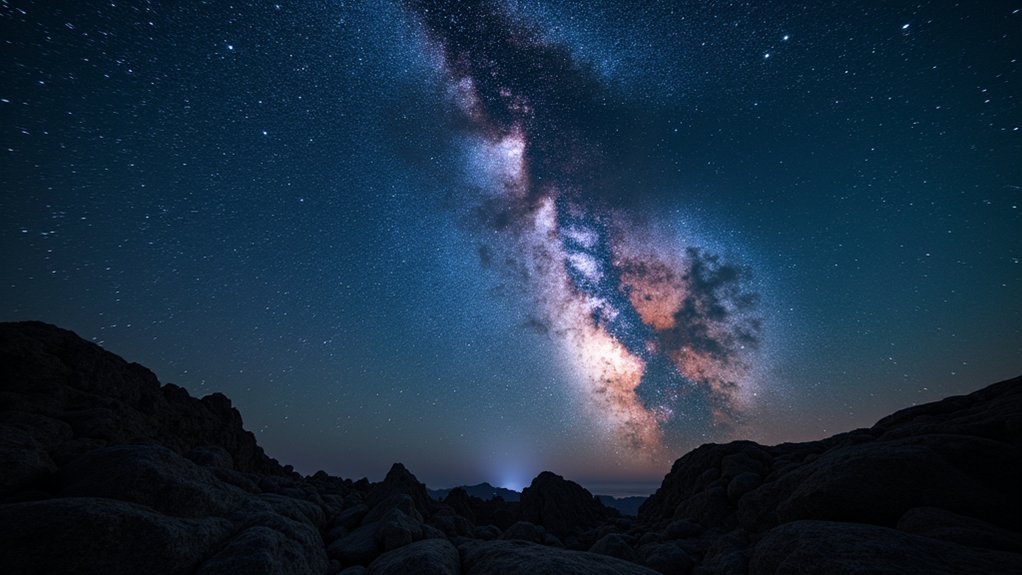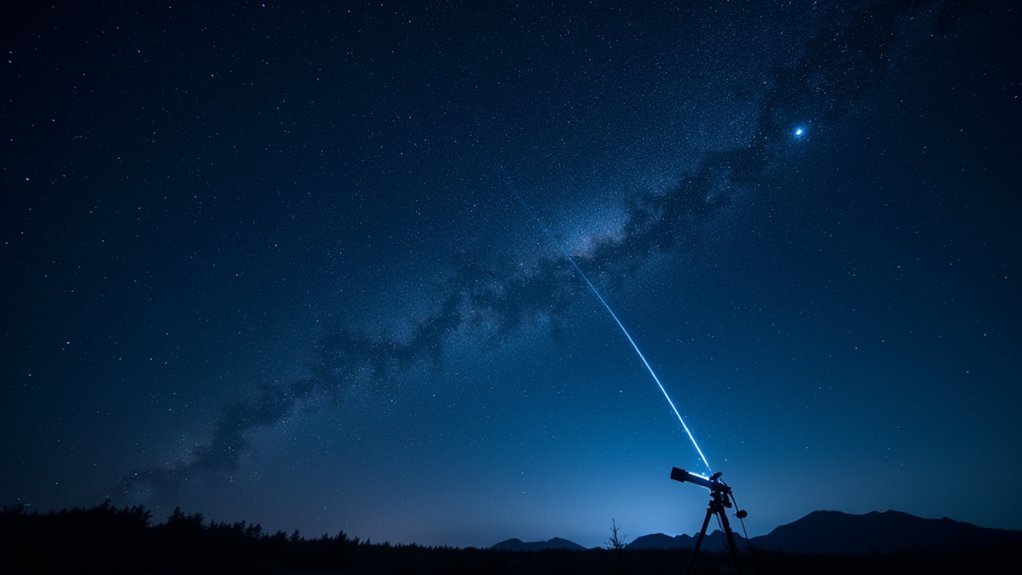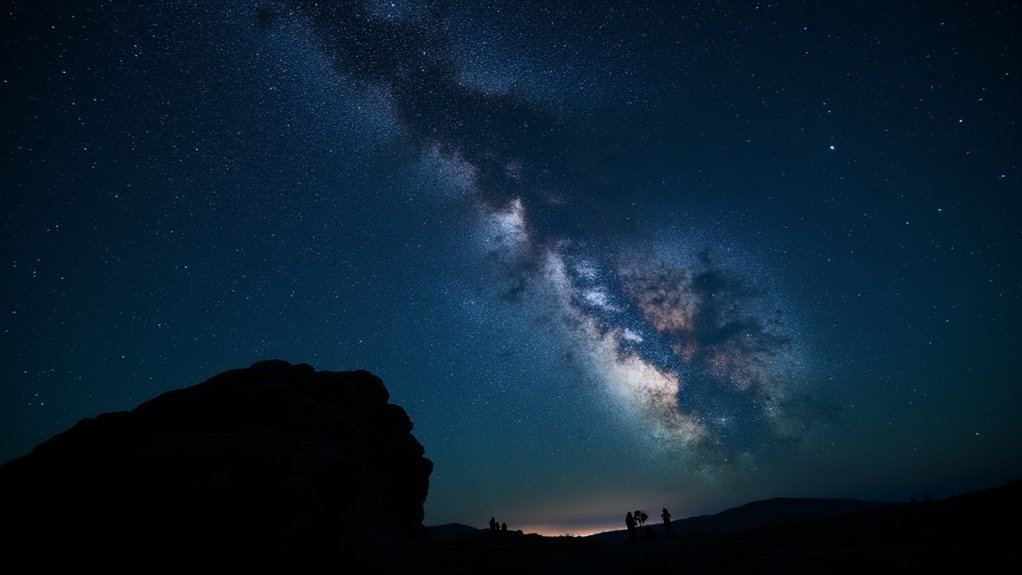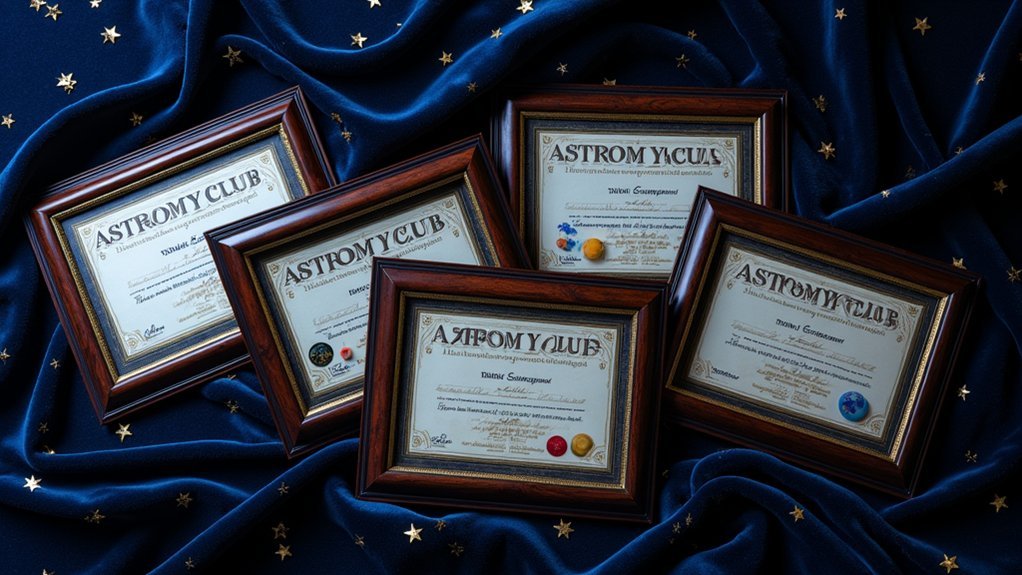The magnitude scale measures star brightness with lower numbers indicating brighter objects. Created by ancient Greek astronomers, this counterintuitive system ranges from negative numbers (extremely bright objects like the Sun at -27) to +6.5 (naked eye limit). Each one-magnitude difference represents a 2.512x brightness change, while a five-magnitude jump equals 100x difference. Your observing equipment and location dramatically affect which celestial objects you’ll spot. Understanding this scale transforms how you’ll experience the night sky.
The Ancient Origins of Stellar Brightness Classification

When you gaze at the night sky, you’re using the same fundamental brightness distinctions that ancient astronomers established over two millennia ago.
The magnitude scale you rely on today originated with ancient Greek astronomers Hipparchus and Ptolemy, who needed a system to catalog stellar brightness.
Hipparchus created a remarkably enduring classification in the 2nd century BCE, dividing stars into six categories of apparent magnitude. The brightest stars earned first magnitude status, while the faintest visible to the naked eye were designated sixth magnitude.
Ptolemy later cemented this system’s influence through his extensive astronomical text, the Almagest.
Though modern astronomy has refined the scale to include negative numbers and precise decimals, you’re still experiencing a direct connection to how our ancestors understood the cosmos.
How the Magnitude Scale Works: Lower Means Brighter
Unlike most measurement systems you’re familiar with, the stellar magnitude scale operates in reverse: the lower the number, the brighter the object. This counterintuitive approach means that extraordinarily bright celestial bodies like the Sun and Moon have negative magnitudes (-27 and -13 respectively).
The magnitude scale creates precise brightness distinctions between stars. Each one-magnitude difference represents a brightness factor of approximately 2.512 times. This means a 1st-magnitude star shines 2.5 times brighter than a 2nd-magnitude star.
A one-magnitude difference makes a star 2.512 times brighter—a simple ratio that brings mathematical precision to stargazing.
Over five magnitudes, this difference compounds to exactly 100 times.
When you’re stargazing without equipment, you’ll typically see objects up to magnitude +6.5—the naked eye limit. Meanwhile, the brightest stars dominate the night sky with magnitudes between 0 and +1.
Decoding the Mathematics Behind Magnitude Differences

Behind the apparent simplicity of the magnitude scale lies a sophisticated mathematical foundation. When you’re comparing stars, you’re actually working with logarithmic relationships, not linear ones.
Every 5-step difference on the apparent magnitude scale represents a brightness factor of 100, while each single step multiplies brightness by approximately 2.512.
- The magnitude scale in astronomy uses the formula m = -2.5 log10(F/F0)
- A star that’s 1 magnitude brighter is actually 2.512 times more luminous
- Negative magnitudes indicate exceptionally bright objects like Sirius (-1.46)
- Absolute magnitude standardizes brightness at 10 parsecs distance
- The Sun’s apparent magnitude (-27) makes it roughly 10 billion times brighter than Sirius
Understanding these mathematical relationships helps you appreciate why the brightness of stars spans such an enormous range while fitting into a manageable numerical scale.
First Magnitude Stars: The Sky’s Brightest Gems
Scattered like jewels across the night canvas, first magnitude stars represent the most brilliant stellar objects visible to the naked eye. With apparent magnitudes ranging from -1.44 to 1.36, these celestial beacons include standouts like blazing Sirius, radiant Canopus, and golden Arcturus.
Of the 21 first magnitude stars adorning our universe, you can spot 15 from the UK, making them perfect targets for your stargazing adventures. Some display variable brightness—Betelgeuse and Antares fluctuate noticeably over time due to their intrinsic properties.
Beyond their beauty, these brightest stars serve a practical purpose as reference points. When you’re observing the night sky, you’ll use them to gauge the brightness of other celestial objects, including passing satellites.
Negative Magnitudes: When Objects Outshine the Scale

While most stars visible to your naked eye have positive magnitudes, a select few celestial objects are so brilliant they require negative numbers on the magnitude scale.
You’ll find our Sun dominates this category with its dazzling -27 magnitude, followed by the Moon at -13, while Venus can reach an impressive -4.5 as the “Evening Star.”
Sirius, the brightest star in our night sky, shines at -1.44, markedly outperforming the faintest stars you can see without a telescope which hover around +6.5.
When Stars Go Bright
Although most celestial objects fit neatly within the positive magnitude scale, some shine so intensely that they break the conventional measurement system altogether.
When you gaze at the night sky, you’re witnessing a brightness spectrum where negative magnitudes represent extraordinary luminosity. Sirius, the brightest star visible at night, has an apparent brightness of -1.44, but that’s just the beginning.
- The Sun dominates with an extreme magnitude of -27
- Our Moon shines at -13 when full
- Venus can reach -4.4, making it a nighttime beacon
- Negative magnitudes follow the same logarithmic scale as positive ones
- A single magnitude difference represents a brightness factor of 2.512
These ultra-bright objects serve as natural navigation tools and remind you of the vast luminosity range in our cosmos.
Our Dazzling Sun
Beyond the exceptional brightness of Sirius lies an entirely different magnitude class dominated by our nearest star. The Sun blazes at an apparent magnitude of approximately -27, making it impossibly bright to measure on the same scale as other celestial objects you observe.
This extreme negative magnitude demonstrates just how luminous our solar system’s center truly is. For comparison, when you gaze at the Full Moon (at -13), you’re seeing something thousands of times dimmer than the Sun, yet still dazzling enough to outshine everything else in the night sky.
Even Venus, reaching an impressive -4.5 during prime viewing conditions, pales against our Sun’s brilliance.
These negative magnitude values aren’t just astronomical curiosities—they help you understand the vast brightness differences between the objects illuminating your sky.
Beyond Zero Point
When celestial objects grow exceptionally bright, they break into negative territory on the magnitude scale, creating an elite category of dazzling sky objects.
You’re witnessing something extraordinary when you observe negative magnitudes—these objects outshine the scale’s zero reference point.
The apparent magnitude system‘s logarithmic nature means each step lower represents 2.512 times more brightness.
The most impressive negative magnitude objects include:
- The Sun dominates at a blinding -27
- Full Moon glows at approximately -13
- Venus can dazzle at -4.4 when conditions are perfect
- The International Space Station reaches -3.9 during prime passes
- Sirius, the night sky’s brightest star, shines at -1.44
When you spot these brilliant objects, you’re seeing celestial bodies so bright they’ve transcended the conventional magnitude scale boundaries astronomers established for typical stars.
Apparent vs. Absolute Magnitude: Distance Matters

When you observe stars in the night sky, you’re seeing apparent magnitudes that can be misleading since distant luminous objects may appear dimmer than closer, less brilliant ones.
Absolute magnitude cuts through this distance distortion by standardizing brightness measurements as if all stars were positioned exactly 10 parsecs from Earth.
This standardization allows you to compare stars’ true luminosities directly, revealing that some seemingly modest stars are actually cosmic powerhouses, while certain bright fixtures in our sky only appear dazzling due to their proximity.
Distance Distorts Brightness
Although stars shine with varying intensities, their perceived brightness from Earth doesn’t tell their full story.
What you’re seeing is the star’s apparent magnitude, which is influenced by both its intrinsic power and its distance from you. A star’s absolute magnitude reflects its true brightness as measured from a standard distance of 10 parsecs (33 light-years).
- A brilliant supergiant might appear dim if it’s hundreds of light-years away.
- A modest star can outshine celestial giants if it’s in your cosmic neighborhood.
- The same star at 100 parsecs appears 25 times fainter than at 20 parsecs.
- Relative brightness changes dramatically with distance—like a flashlight seen from across a field versus a room.
- Comparing apparent and absolute magnitudes helps you determine how far away stars actually are.
Measuring True Luminosity
To grasp a star’s true brightness, you’ll need to understand the critical distinction between apparent and absolute magnitude.
When you observe stars in the night sky, you’re seeing their apparent magnitude—how bright they appear from Earth, affected by both distance and interstellar dust.
Absolute magnitude reveals a star’s intrinsic luminosity by standardizing the distance to 10 parsecs (33 light-years). This allows you to compare how luminous different celestial objects truly are.
The relationship follows a logarithmic scale where a 5-magnitude difference equals a brightness factor of 100.
Consider our Sun: it has an apparent magnitude of -26.832 (extremely bright from Earth) but an absolute magnitude of just +4.83.
This measurement system helps astronomers calculate stellar distances and study evolutionary patterns across the universe.
Standardizing Star Comparisons
Since stars reside at vastly different distances from Earth, comparing their brightness requires standardized methods that account for these spatial differences.
When you observe the night sky, you’re seeing apparent magnitude—the brightness as viewed from Earth. But this doesn’t tell the whole story. Absolute magnitude reveals a star’s true luminosity by standardizing distance to 10 parsecs (33 light-years). This distinction helps you understand a star’s intrinsic properties rather than just its visible brightness.
- A 5-magnitude difference represents a 100× change in brightness
- Negative values on the magnitude scale indicate exceptionally bright objects
- Apparent magnitude can be misleading—a dim nearby star might appear brighter than a distant supergiant
- The Sun’s apparent magnitude (-27) differs drastically from its absolute magnitude (+4.8)
- Absolute magnitude enables accurate comparison of stars’ true luminosities
Limiting Magnitudes: What Can You Actually See?

How bright must a star be for you to actually see it? The answer depends on your equipment and viewing conditions. Under ideal circumstances, your naked eye can detect stars down to a limiting magnitude of about +6.5. The faintest stars visible shift dramatically with light pollution and atmospheric conditions.
With basic equipment, you’ll expand your visual magnitudes considerably. Standard binoculars push your limit to approximately +12.1, while small telescopes reach around +13.6.
Stepping up to larger instruments yields even more impressive results—a 200mm telescope reveals stars to +15.1, while a 300mm reaches +15.6.
For context, professional instruments like the Hubble Space Telescope can detect objects as faint as magnitude +30—roughly one billionth the brightness of what your unaided eye can perceive.
The Impact of Light Pollution on Stellar Visibility
While standing under dark rural skies reveals thousands of twinkling stars, urban environments dramatically reduce this celestial display.
Light pollution creates a bright atmospheric background that masks fainter celestial objects, considerably altering what’s visible to the naked eye.
In urban areas, you’ll typically only see stars brighter than magnitude +3, compared to magnitude +6.5 in dark locations. You can assess your local conditions by determining your limiting magnitude—the faintest stars you can detect.
- First-magnitude stars remain visible even in well-lit cities
- Moderately light-polluted areas show stars to about magnitude +4
- Suburban skies typically reveal stars to magnitude +4 or +5
- Rural locations may display stars to magnitude +6
- Dark sky parks offer ideal viewing with magnitudes approaching +6.5
To improve your stargazing experience, seek darker locations away from artificial lighting.
Telescope Power: Reaching Fainter Magnitudes
While larger aperture telescopes can dramatically extend your viewing capacity—with a 300mm instrument revealing stars nearly 10 magnitudes fainter than the naked eye can detect—it’s the light-gathering power rather than magnification that truly matters for seeing dim objects.
You’ll find that each doubling of aperture diameter lets you see stars about 1.5 magnitudes fainter, following the logarithmic relationship expressed in the formula m = 3.6 + 5log(D).
Even the most powerful amateur telescopes will struggle to reach their theoretical magnitude limits in urban environments, where light pollution can effectively reduce your instrument’s capabilities by several magnitudes.
Aperture Size Matters
The single most important factor in determining what stars you’ll see is your telescope’s aperture size. The formula m = 3.6 + 5log(D) helps you calculate the limiting magnitude your instrument can achieve.
As aperture doubles, you’ll gain about 1.5 magnitudes in brightness detection.
- A 100mm telescope reveals stars down to magnitude 13.6
- Upgrading to 200mm lets you see stars at magnitude 15.1
- At 300mm, you’ll detect stars as faint as magnitude 15.6
Each magnitude step represents 2.512 times more brightness. Your local conditions (light pollution, atmosphere) will affect these theoretical limits.
Remember that your telescope’s aperture determines its light-gathering ability. When you’re deciding on equipment, prioritize aperture size if you’re keen on observing fainter celestial objects.
Magnification vs. Light-Gathering
Many amateur astronomers mistakenly focus on magnification when what truly matters for seeing faint objects is light-gathering power. The magnitude scale reveals this truth—each step represents a brightness difference of approximately 2.512 times the light emitted from celestial objects.
While your naked eye under good conditions can only detect stars brighter than magnitude +6.0, telescopes dramatically extend this limit. The larger the aperture, the fainter the objects you’ll observe. A 100mm telescope reaches magnitude 13.6, while a 300mm telescope detects stars to magnitude 15.6—millions of times fainter than visible to the unaided eye.
Don’t be deceived by claims of extreme magnification. Even binoculars max out around magnitude 12.1, while professional instruments like Hubble can detect astonishingly faint objects approaching magnitude +30.
Urban Light Pollution
Despite your telescope’s theoretical magnitude limits, urban light pollution severely restricts what you’ll actually see. While a large 200mm telescope might reach magnitude +15 under dark skies, city lights often cap visibility around magnitude +10 or brighter. The contrast between astronomical objects and the artificially brightened sky simply overwhelms faint targets.
To maximize your urban stargazing experience:
- Use light pollution filters that block specific wavelengths of artificial light
- Target brighter objects (planets, Moon, bright star clusters) when viewing from city locations
- Understand that magnitude limits in catalogs assume dark-sky conditions
- Try to observe during exceptionally clear nights when pollution is minimized
- Consider occasional trips to darker locations to experience your telescope’s true capabilities
These strategies help you work within urban constraints while still enjoying the universe’s brightest treasures.
Solar System Objects on the Magnitude Scale
While astronomers use the magnitude scale to measure stellar brightness, our own solar system contains objects that span an extraordinary range on this scale. The Sun dominates at magnitude -27, vastly outshining everything else in our sky.
At night, the Full Moon takes center stage at magnitude -13, bright enough to cast shadows on Earth.
Venus, often called the “Evening Star,” can reach an impressive -4.4 magnitude, making it the brightest planet visible in our solar system.
Mars varies considerably, reaching -2.8 during close approaches, while distant Uranus and Neptune remain faint at magnitudes 5.7 and 7.6 respectively.
This range illustrates why some solar system objects command our attention, while others require telescopes to detect at all.
Color Filters and Specialized Magnitude Measurements
Beyond the basic brightness measurements of solar system objects, modern astronomy employs sophisticated color filtering techniques to extract even more information from starlight. When you observe stars through the UBVRI system, you’re seeing stellar brightness across specific wavelength bands that reveal temperature, composition, and evolutionary status.
- Color filters isolate light from ultraviolet (320-400 nm) to visual (500-700 nm) wavelengths
- Differences between filtered measurements create color indices that indicate stellar temperature
- Specialized magnitude measurements detect brightness variations invisible to the naked eye
- Variable stars require precise filtering techniques to track their changing luminosity patterns
- The UBVRI system’s standardized approach guarantees consistent measurements across different observatories
These specialized techniques transform simple brightness observations into detailed stellar portraits, allowing you to perceive subtle differences between seemingly identical stars and understand their true nature.
Surface Brightness: Why Some Galaxies Are Hard to See
Three essential factors determine whether you’ll spot a galaxy in the night sky, and total magnitude is just one of them. Surface brightness—how the light spreads across a galaxy’s visible area—plays a significant role in visibility.
Total magnitude alone won’t reveal whether a galaxy is visible—surface brightness determines if its light can overcome the sky’s background glow.
Consider the Triangulum Galaxy (M33). With a magnitude of 5.73, it should be visible to the naked eye. Yet you’ll struggle to see it without a telescope because its light disperses across a large area, resulting in low surface brightness.
Unlike stars that concentrate light in pinpoint sources, galaxies spread their luminosity over vast regions. This diffusion makes them appear faint against the sky background.
Surface brightness is measured in magnitudes per square arcminute, explaining why objects with seemingly adequate brightness remain challenging to observe, especially under light-polluted skies.
Practical Applications for Amateur Stargazers
Understanding surface brightness helps explain why some celestial objects remain hidden despite favorable magnitude ratings. As you begin your stargazing journey, the magnitude scale becomes your essential brightness decoder, helping you determine what’s visible with your equipment.
- Stars brighter than +6.5 are visible to your naked eye in good conditions
- Binoculars extend your viewing potential to approximately magnitude +10
- First magnitude stars like Sirius (-1.44) and Vega (0.00) serve as valuable reference points
- Star atlases and apps displaying magnitude ratings optimize your observation planning
- Tracking satellites requires understanding their magnitude range (ISS ranges from 0 to -3.9)
When you’re dealing with light pollution, knowing these brightness thresholds helps you set realistic expectations and choose appropriate targets for your binoculars or a telescope.
Frequently Asked Questions
What Is the Brightness and Magnitude Scale of Stars?
The magnitude scale ranks star brightness logarithmically from bright (low/negative numbers) to dim (high numbers). You’ll see 1st magnitude stars easily, while 6th magnitude stars are barely visible to your naked eye.
How Much Brighter Is a Magnitude +2 Star Than a Magnitude +4 Star?
A magnitude +2 star is about 6.3 times brighter than a magnitude +4 star. You’ll notice this significant difference when you’re stargazing, as the +2 star appears much more prominent.
How Much Is a Magnitude 1 Star Brighter Than a Magnitude 3 Star?
A magnitude 1 star is about 6.31 times brighter than a magnitude 3 star. You’ll notice this significant difference because each magnitude step represents a brightness factor of 2.512 compounded twice.
How Bright Is a Magnitude 3.0 Star Compared to a Magnitude 4.0 Star?
A magnitude 3.0 star is about 2.5 times brighter than a magnitude 4.0 star. You’ll notice this significant difference when stargazing, as the 3.0 star appears noticeably more luminous to your eye.
In Summary
You’ve now got the tools to decode the night sky’s brightness code. Whether you’re tracking Venus’s brilliant -4.6 or hunting for a +9 galaxy, the magnitude scale will be your constant companion. Next time you’re under the stars, you’ll appreciate how this ancient system has evolved into the precise language astronomers use to communicate the universe’s varying brilliance.





Leave a Reply